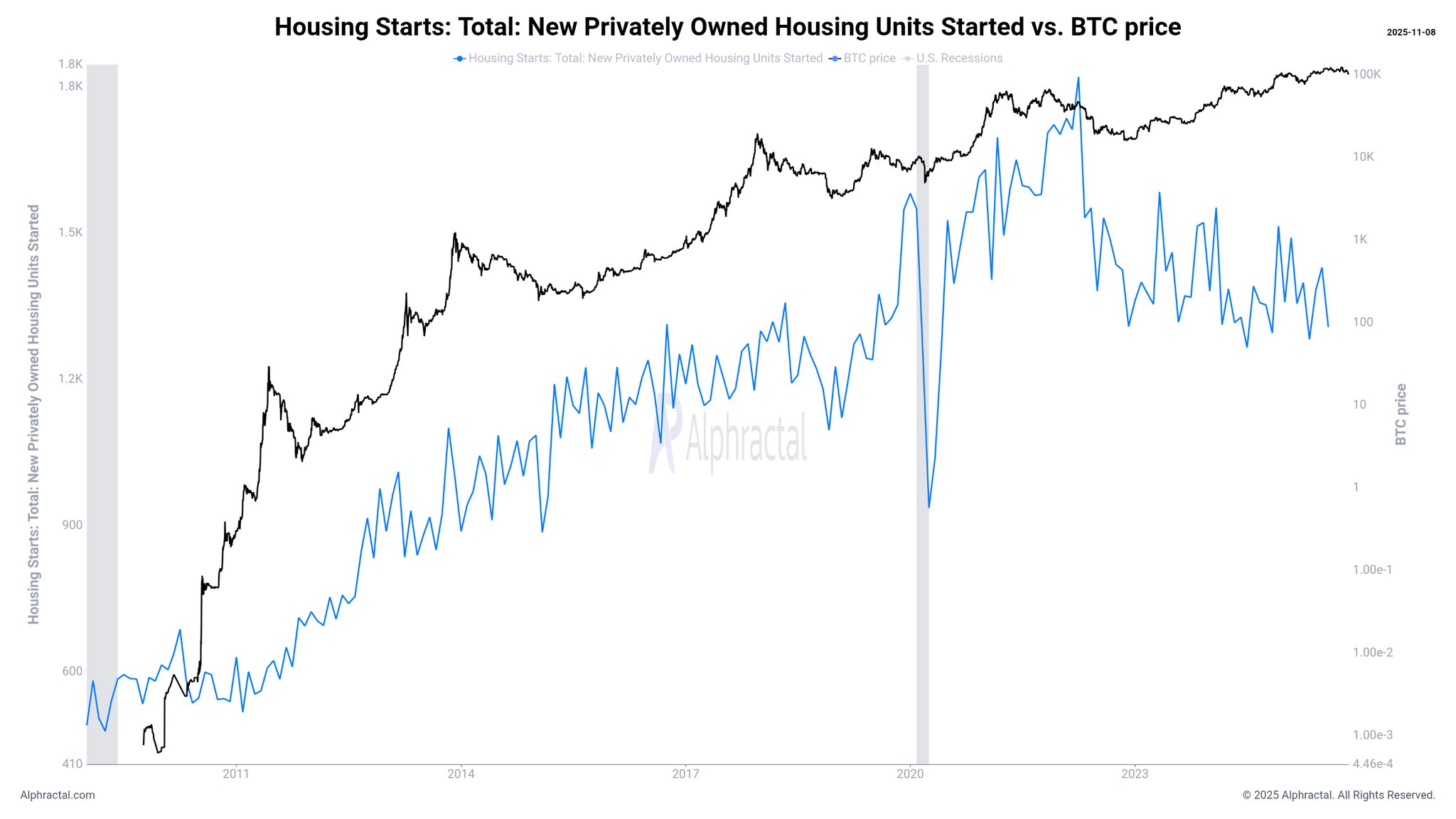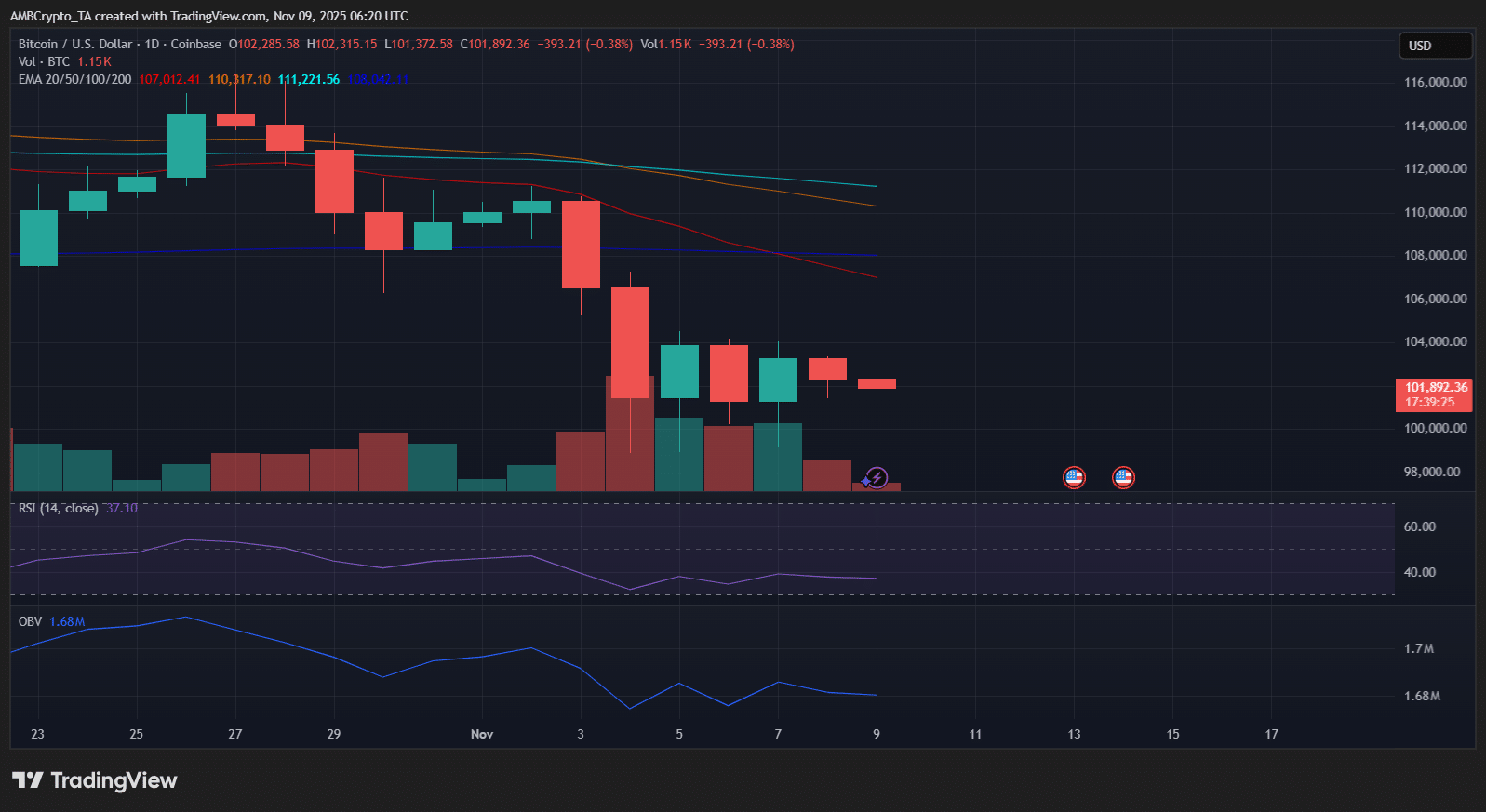Bitcoin price stability amid U.S. market decline remains intact, with BTC holding above $100,000 despite falling Housing Starts and a softening S&P 500. This resilience signals potential liquidity shifts to crypto as economic indicators weaken.
-
Bitcoin holds key support at $100K as traditional markets face pressure from declining housing data.
-
Housing Starts are trending lower, an early warning of economic slowdown that often precedes broader market volatility.
-
RSI at 37 indicates fading momentum, with potential downside to $90K-$95K if support breaks, per TradingView analysis.
Discover Bitcoin price stability amid U.S. market decline: BTC stays above $100K despite Housing Starts drop. Explore implications for crypto investors now.
What is driving Bitcoin’s resilience amid U.S. market softening?
Bitcoin price stability amid U.S. market decline is evident as BTC maintains levels above $100,000, even with indicators like declining Housing Starts and a turning S&P 500 pointing to economic fatigue. This decoupling from traditional assets suggests growing investor confidence in cryptocurrency as a hedge. Factors such as institutional adoption and anticipation of Federal Reserve policy shifts contribute to this strength, allowing BTC to form higher lows while equities correct.
How are declining Housing Starts impacting market sentiment?
Housing Starts, which measure new privately-owned residential construction in the U.S., have begun to roll over, dropping to levels not seen since mid-2024 according to data from the U.S. Census Bureau. This decline, now at approximately 1.3 million units annualized, signals softening demand and tighter financing conditions amid higher interest rates. Historically, such patterns have preceded equity market volatility, with the S&P 500 experiencing corrections of 5-10% in similar prior cycles. Experts like those at Alphractal note that this gap between housing trends and stock highs has rarely persisted without repercussions. “Housing data often acts as the canary in the coal mine for broader economic health,” stated a senior economist from the Federal Reserve Bank of New York in a recent report. The chart below illustrates this divergence clearly, with Housing Starts in blue declining while the S&P 500 in orange pushes to new peaks.

Source: Alphractal
In past instances, this misalignment has led to unwinding of bullish positions in equities, with the VIX index spiking by an average of 20% within weeks. For cryptocurrency markets, however, Bitcoin has shown relative strength, trading independently of these pressures. This behavior aligns with observations from the 2022 downturn, where BTC recovered faster than traditional indices during recovery phases. Current on-balance volume (OBV) metrics from TradingView further support a cautious outlook, as inflows remain subdued.

Source: Alphractal
The broader context includes persistent inflation concerns, with the Consumer Price Index hovering around 2.5% year-over-year as reported by the Bureau of Labor Statistics. Builders are pulling back due to elevated mortgage rates near 7%, reducing starts by 4.2% month-over-month. This data underscores a cooling in consumer spending, a key driver of U.S. GDP, which grew at a modest 2.1% in the latest quarter per Commerce Department figures.
Frequently Asked Questions
Why is Bitcoin holding above $100K during U.S. economic slowdown?
Bitcoin’s position above $100,000 stems from its role as a digital store of value, attracting inflows from investors seeking alternatives to weakening equities. Institutional holdings, now exceeding 1 million BTC according to on-chain data from Glassnode, provide a strong floor. This stability persists despite Housing Starts declines, highlighting crypto’s decoupling from traditional market cycles in 2025.
Could a Bitcoin price drop follow the S&P 500 correction?
If the S&P 500 continues its downturn, Bitcoin might test lower supports around $95,000, but historical patterns from April 2025 suggest BTC could maintain relative strength. With RSI not yet oversold and volume stabilizing, a quick rebound is possible if Federal Reserve signals dovish policy. Investors should monitor key EMAs for directional cues.
Key Takeaways
- Housing Starts signal early economic weakness: Declines in new construction precede broader market volatility, as seen in historical data from the U.S. Census Bureau.
- Bitcoin demonstrates resilience: BTC’s hold above $100K amid S&P 500 softening indicates potential liquidity rotation into crypto assets.
- Monitor support levels closely: A break below $100K could lead to $90K-$95K, urging investors to watch RSI and OBV indicators for entry points.
Conclusion
In summary, Bitcoin price stability amid U.S. market decline underscores its maturation as an asset class, particularly against indicators like falling Housing Starts and equity pullbacks. As traditional markets grapple with fatigue, crypto’s decoupling offers opportunities for diversification. Looking ahead, a Federal Reserve pivot could bolster BTC further—investors are advised to stay informed on macroeconomic releases for strategic positioning.
Housing starts are sending a warning
Housing Starts, representing new privately-owned homes under construction in the U.S., are declining once more, a pattern that has seldom been insignificant in economic cycles. This metric often emerges as one of the first signs of slowdown: buyer demand wanes, lending tightens, and construction activity contracts. Visual aids from market analysis platforms highlight the contrast between these falling figures and the S&P 500’s recent record highs, a divergence that has historically resolved with increased volatility in stocks.
The U.S. economy exhibits clear signs of strain, and housing metrics frequently lead in revealing such underlying issues. Data from the U.S. Census Bureau shows a 3.8% drop in starts for October 2025, bringing totals to 1.32 million units on a seasonally adjusted annual basis. This follows a brief uptick earlier in the year, but persistent challenges like affordability barriers and supply chain remnants from prior years are weighing heavy. In comparison, the S&P 500 has climbed 15% year-to-date, driven by tech sector gains, yet this optimism may be tested as residential investment—a component of GDP—continues to falter.
Equity markets have not sustained such gaps indefinitely in previous downturns. For instance, during the 2018 slowdown, a similar housing pullback preceded a 20% correction in major indices. Positioning in overextended sectors could unwind rapidly, with implied volatility metrics like the VIX potentially rising from current levels around 18 to 25 or higher. For cryptocurrency enthusiasts, this environment reinforces Bitcoin’s appeal as a non-correlated asset, with on-chain transaction volumes holding steady at over $50 billion daily, per blockchain analytics from Chainalysis.
Here’s the next tell
With the S&P 500 now showing signs of reversal, attention turns to whether Bitcoin will follow suit or diverge further by avoiding new lows. A scenario where BTC preserves its higher-low pattern during an equity pullback mirrors dynamics observed in April 2025, marking a display of comparative strength and early accumulation phases. Institutional investors, holding over 5% of BTC supply according to reports from Ark Invest, may be positioning accordingly amid these shifts.
Conversely, should the $100,000 threshold breach, the subsequent support cluster near $90,000 becomes vulnerable, with rapid declines possible in low-volume conditions. Historical precedents, such as the March 2024 dip, saw BTC retrace 12% before rebounding on ETF inflow news. Current sentiment, gauged by the Crypto Fear & Greed Index at 45 (neutral), suggests room for both upside and downside, but momentum favors caution.
A decision zone
From a technical standpoint on the daily timeframe, Bitcoin remains anchored above the $100,000 mark as of late November 2025, though overall momentum appears subdued. The Relative Strength Index (RSI) hovers around 37, indicating the asset is not yet in oversold territory but lacking strong buying conviction. Trading volume has decreased by 15% week-over-week, and the On-Balance Volume (OBV) indicator trends downward, hinting at reduced accumulation from large holders.

Source: TradingView
Additionally, BTC’s price action is constrained beneath pivotal exponential moving averages (EMAs), including the 50-day at $102,500 and the 200-day at $98,200, tilting short-term bias toward bears. The forthcoming price movement will be pivotal: defending this zone could foster a consolidation base for renewed upside, potentially targeting $110,000. A failure here, however, paves the way for tests of the $95,000-$98,000 range, where prior accumulation zones might attract value seekers. Market participants should track upcoming employment data and Fed minutes, as these could influence cross-asset flows. Overall, Bitcoin’s performance in this juncture will offer insights into its maturity relative to traditional finance, with global adoption metrics from Cambridge Centre for Alternative Finance showing 420 million crypto users worldwide as of 2025.
